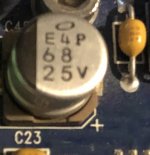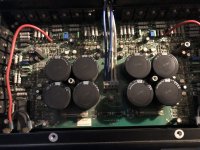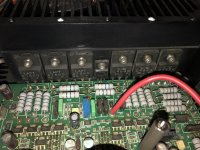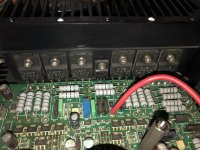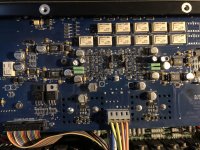Hi to everybody.
Have krell kav400xi, and maybe it is time to recap.
On the preamplifier board (but on the power section too), there are dozen of SMD capacitors of unknown brand and, more important, type.
Done extensive search on google, but no results returned.
Attached picture of one of these.
Appreciate any help
Have krell kav400xi, and maybe it is time to recap.
On the preamplifier board (but on the power section too), there are dozen of SMD capacitors of unknown brand and, more important, type.
Done extensive search on google, but no results returned.
Attached picture of one of these.
Appreciate any help
Attachments
These are standard aluminium electrolytics that should be available from pretty much any major component retailer. Be very careful with polarity if you remove any, perhaps take photos of the board first as a record.
The black vertical print is the negative side.
They smell of fish when exhausted as they are organic electrolytics originally manufactured exclusively by Sanyo Semiconductors Ltd in Japan.
They smell of fish when exhausted as they are organic electrolytics originally manufactured exclusively by Sanyo Semiconductors Ltd in Japan.
Thank you very much for your answers.
I was told that in kav-280p (so, the same kav series), those caps are actually aluminium solid/polymer type- so they should not be replaced, as they are od long life and high temperature endurance.
To be honest, the amp worked excellent until recently, as I have noticed a subtle sound thining. The most obvious reason for such behaviour could be the power supply caps in the first place- but what if the problem is somwhere in a zillion smd caps, since notoriously known pretty high working temperature of this model.
Shortly, I’m in doubt to start ful recap and what to replace at all.
I was told that in kav-280p (so, the same kav series), those caps are actually aluminium solid/polymer type- so they should not be replaced, as they are od long life and high temperature endurance.
To be honest, the amp worked excellent until recently, as I have noticed a subtle sound thining. The most obvious reason for such behaviour could be the power supply caps in the first place- but what if the problem is somwhere in a zillion smd caps, since notoriously known pretty high working temperature of this model.
Shortly, I’m in doubt to start ful recap and what to replace at all.
Last edited:
.. pretty sure that these are not OS-CONs, ordinary electrolytics instead. Not that easy to replace them, there is always the risk of damaging the PCB pad underneath the caps.
Hi to everybody.
Have krell kav400xi, <snip>
BEFORE YOU START. Take lots of pictures !
It's a little hard to get size scale from that pic but I'm guessing size D.
https://industrial.panasonic.com/cdbs/www-data/pdf/RDE0000/ABA0000C1184.pdf
First page, lower right "dimensions" shows size codes B through G.
I've not worked on Krell amps but on lots of broadcast gear. When I
buy parts I look for ripple current (most), temperature (105, 125C) and
obviously size, value and Voltage. Odds are very high that the caps you get
today will be a higher Voltage for a given size. Higher Voltage is no problem.
Most places the height isn't a big deal but pay attention. Some of the
early (the Krell is from 2003?) SMD low profile caps can be difficult to find.
Note the base of the cap has 2 of the corners chamfered. That is the positive
terminal. Just line up the outline.
Now to the hard part. How to get them off the board without damage. I've tried
several methods but the one I've found to be the best is this
YouTube
The tool I use is a side cutter rather than the pliers for 2 reasons. You don't
always have room for the pliers and I think it's important to put a little
pressure on the board so that you don't pull off the pad. The shear strength
is quite good but tensile not as much. And rather than a half turn, I do about
an 1/8 turn left and right. Part of the time the lead stays on the cap but most
of the time the lead is still on the board and has to get removed.
My pad destruction rate is better than 1 in 500.
Rather than a squirt bottle I use a flux pen like this
https://www.digikey.com/product-detail/en/mg-chemicals/835-P/473-1033-ND/949475
I flux the pads, add solder to the pads so I now have a lump and using a good
old Edsyn Soldapullt vacuum of the solder and the lead. The heated vacuum tools
don't have a large enough hole to get the pin with the solder. BTW keep the
Soldapullt clean and lubed. The silicone gasket sealer at a pool supply store works well.
Now clean off the solder flux. I use
4140 - Flux Remover for PC Boards - Flux Removers | MG Chemicals
Digikey doesn't have this so I get it from Mouser by the liter. It's mostly alcohol
based and damages almost nothing. Cotton swabs and flux remover should leave
the board looking new.
Add a dot of flux on the pads and tack the first pin to hold it, solder the other pin
and come back to properly solder the first pin. Clean off the flux and you're done.
There are SO many caps to replace at work that I paint the tops with a green sharpie to
keep track of them and print a tag with the date.
My only gripe with the YouTube guy is that soldering tusk. Please use something better
as too high a temperature can ruin the bond of the copper to the board. Some OLD
consumer boards have lost pads at 700 but are OK at 600.
If you can afford a Krell, you can get good tools. If you try a Metcal iron
I promise you won't regret it. Your only complaint was not getting one sooner.
G²
Last edited:
.. pretty sure that these are not OS-CONs, ordinary electrolytics instead. Not that easy to replace them, there is always the risk of damaging the PCB pad underneath the caps.
Agreed. The Krell is from 2003 and I don't think polymer caps were available.
G²
If you can afford a Krell, you can get good tools. If you try a Metcal iron
I promise you won't regret it. Your only complaint is not getting one sooner.
G²
True...
You could get a low cost esr meter, and do some comparisons to other parts to determine what the characteristics are, or just cut one apart too I suppose.
Sanyo OSCONs were available before 2002 as the file at https://industrial.panasonic.com/content/data/CP/PDF/OS-CON_EOL_E.pdf shows. It is not obvious to me that the subject capacitor is ordinary aluminum electrolytic. Jumping in to replace it without knowing exactly what the original part is would not be prudent.
Only replace the ones that smell of fish!
I have been in the trade for over 50years and experience tells me that a pre 2005 component is more than likely organic.
Getting them off the board is easy.
Use lots of flux and a hot fine pointed tip on your iron.
Heat one side and gently prise it slightly in the upwards direction, then the other side and keep going a bit at a time.
Remember flux is essential!
I have been in the trade for over 50years and experience tells me that a pre 2005 component is more than likely organic.
Getting them off the board is easy.
Use lots of flux and a hot fine pointed tip on your iron.
Heat one side and gently prise it slightly in the upwards direction, then the other side and keep going a bit at a time.
Remember flux is essential!
Last edited:
Wow...seems things are going to be more and more complicated. ��
I was confused mainly by the fact (if it is true) that the corresponding kav280p are polymer caps. If so, it seems logical to me for kav400 too, since its preamp is derived from kav280p.
Further confused by the fact that there is no information about the unusual marking on the top of the capacitors.
I was confused mainly by the fact (if it is true) that the corresponding kav280p are polymer caps. If so, it seems logical to me for kav400 too, since its preamp is derived from kav280p.
Further confused by the fact that there is no information about the unusual marking on the top of the capacitors.
@stratus46
Thanx a lot for sharing your experience, it is a most valuable thing, especially as there is a number of techiques of resoldering.
I’ll attach here some more pictures, just to show a whole amp.
No one capacitors seems bad, even those standard electrolytics being very close to heatsinks (united chemicon standard 105C caps).
And, yes, I afforded the Krell not new, but as second hand unit, and really love it����
Thanx a lot for sharing your experience, it is a most valuable thing, especially as there is a number of techiques of resoldering.
I’ll attach here some more pictures, just to show a whole amp.
No one capacitors seems bad, even those standard electrolytics being very close to heatsinks (united chemicon standard 105C caps).
And, yes, I afforded the Krell not new, but as second hand unit, and really love it����
Attachments
Last edited:
Those tiny caps are the WORST.
And yeah, when unsoldering them, they smell like fish.
Never liked them.
And yeah, when unsoldering them, they smell like fish.
Never liked them.
- Status
- Not open for further replies.
- Home
- Design & Build
- Parts
- SMD capacitor of unknown type and marking
